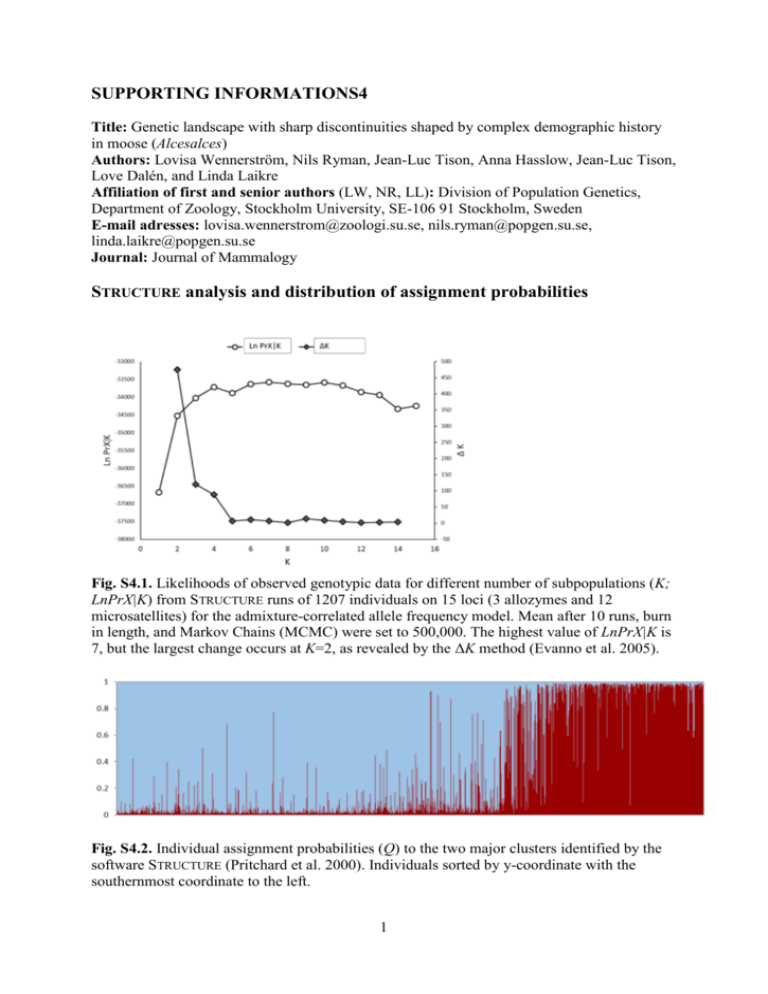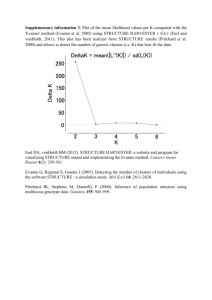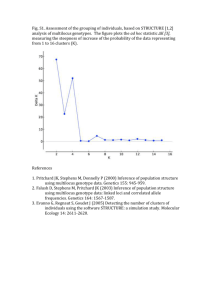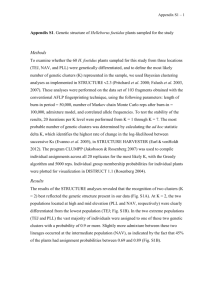Structure analysis and distribution of assignment probabilities
advertisement

SUPPORTING INFORMATIONS4 Title: Genetic landscape with sharp discontinuities shaped by complex demographic history in moose (Alcesalces) Authors: Lovisa Wennerström, Nils Ryman, Jean-Luc Tison, Anna Hasslow, Jean-Luc Tison, Love Dalén, and Linda Laikre Affiliation of first and senior authors (LW, NR, LL): Division of Population Genetics, Department of Zoology, Stockholm University, SE-106 91 Stockholm, Sweden E-mail adresses: lovisa.wennerstrom@zoologi.su.se, nils.ryman@popgen.su.se, linda.laikre@popgen.su.se Journal: Journal of Mammalogy STRUCTURE analysis and distribution of assignment probabilities Fig. S4.1. Likelihoods of observed genotypic data for different number of subpopulations (K; LnPrX|K) from STRUCTURE runs of 1207 individuals on 15 loci (3 allozymes and 12 microsatellites) for the admixture-correlated allele frequency model. Mean after 10 runs, burn in length, and Markov Chains (MCMC) were set to 500,000. The highest value of LnPrX|K is 7, but the largest change occurs at K=2, as revealed by the ΔK method (Evanno et al. 2005). Fig. S4.2. Individual assignment probabilities (Q) to the two major clusters identified by the software STRUCTURE (Pritchard et al. 2000). Individuals sorted by y-coordinate with the southernmost coordinate to the left. 1 Fig. S4.3.Distribution of assignment probabilities. Left: Admixture proportion, i.e., lowest assignment probability to either of the 2 major clusters identified by STRUCTURE (Pritchard et al. 2000) coded in a gray scale. Dark-black color indicates that the lowest assignment probability to 1 of the 2 clusters is very low, and the probability of belonging to the other cluster is high which implies low admixture between the 2 clusters in a region. Light colors indicate that the lowest assignment probability to 1 of the clusters is relatively high, and the probability to belong to either cluster is therefore rather low. Thus, higher probability values (light colors) imply higher admixture between the clusters. Right: The 1207 individuals genotyped for 12 microsatellite and 3 allozyme loci split into 4 groups based on the STRUCTURE results and the gray scale assignment probability illustration; a northern cluster, a southern cluster, and a transition zone between them, also divided into one northern and one southern part. 2











